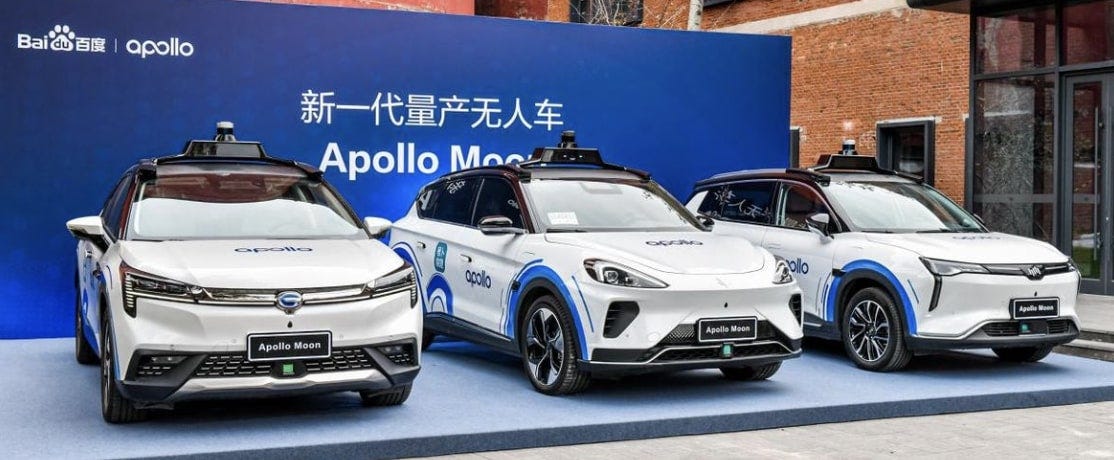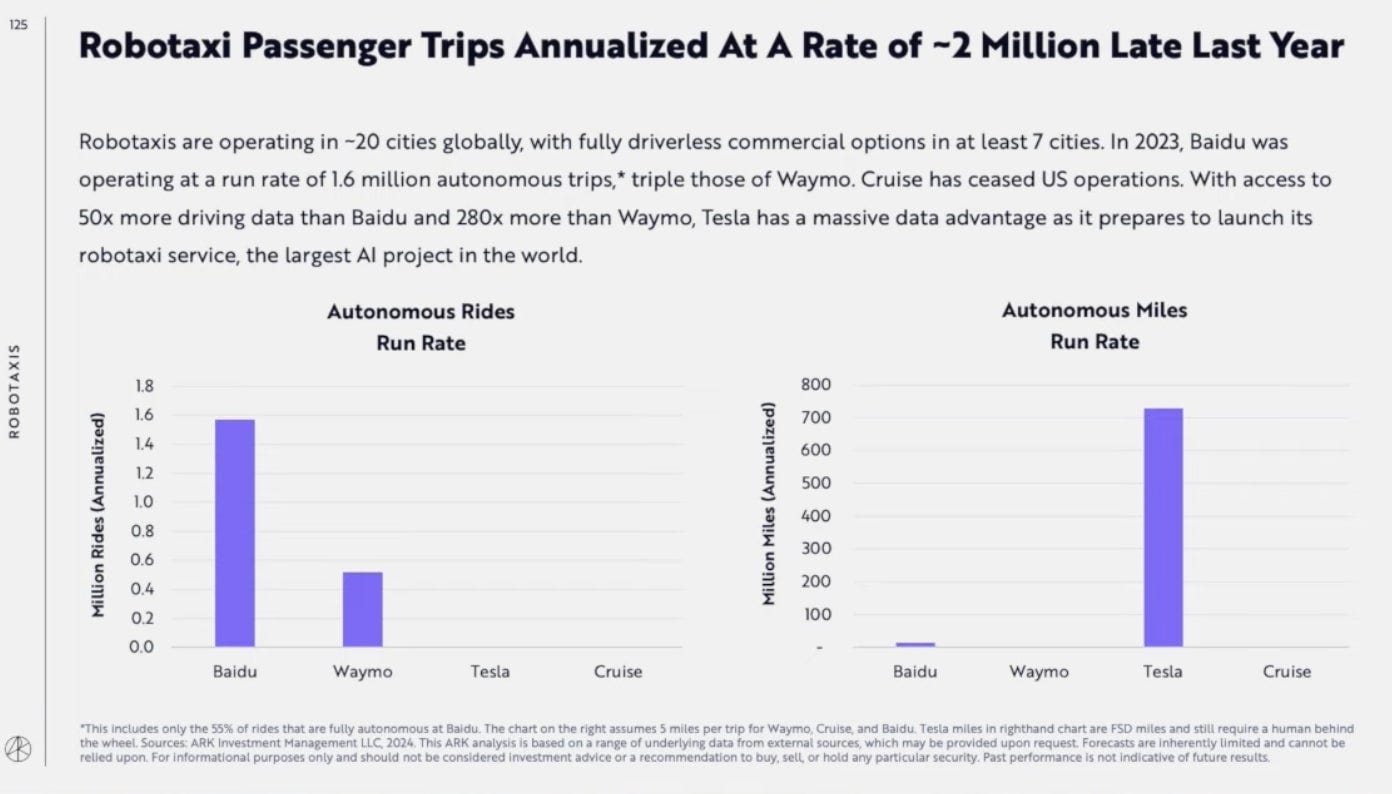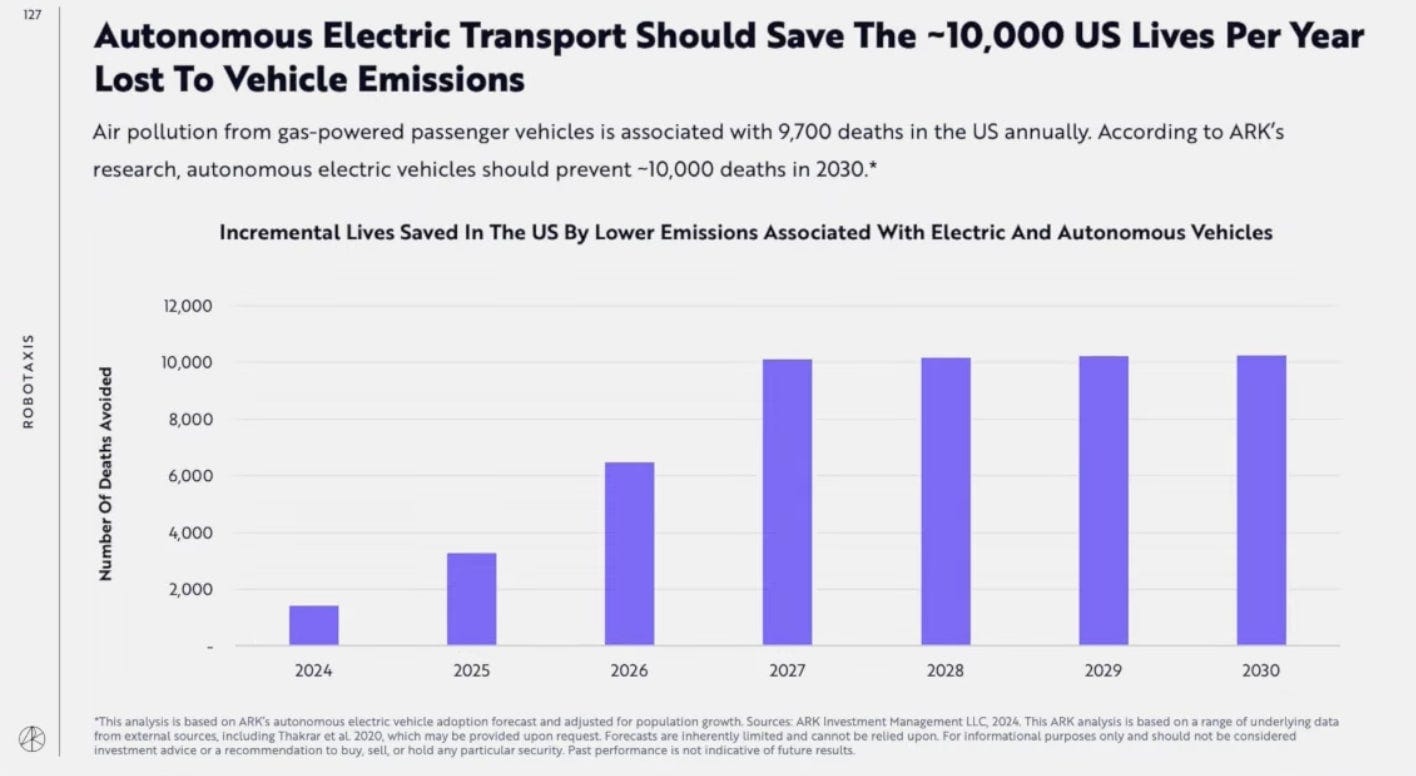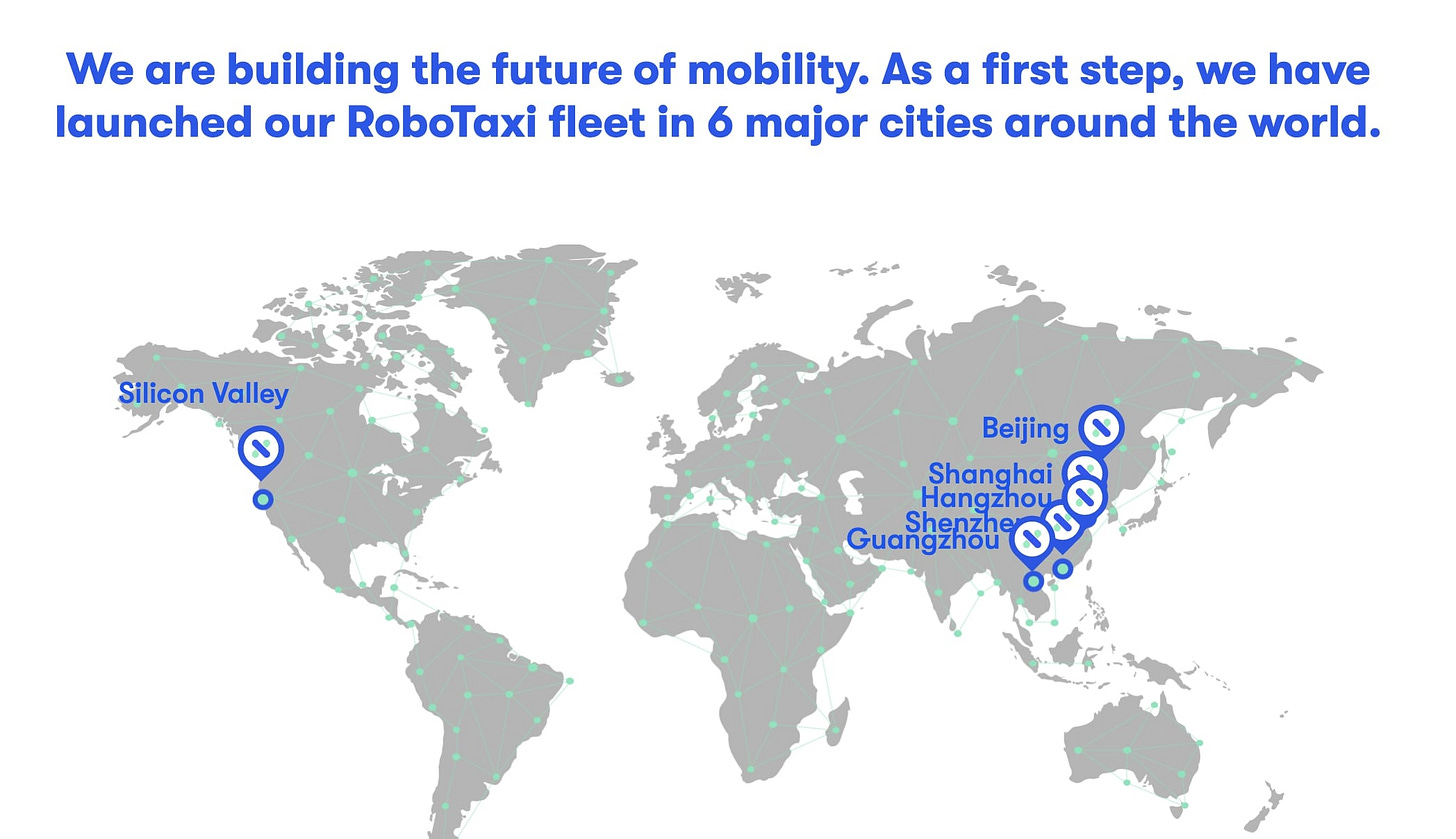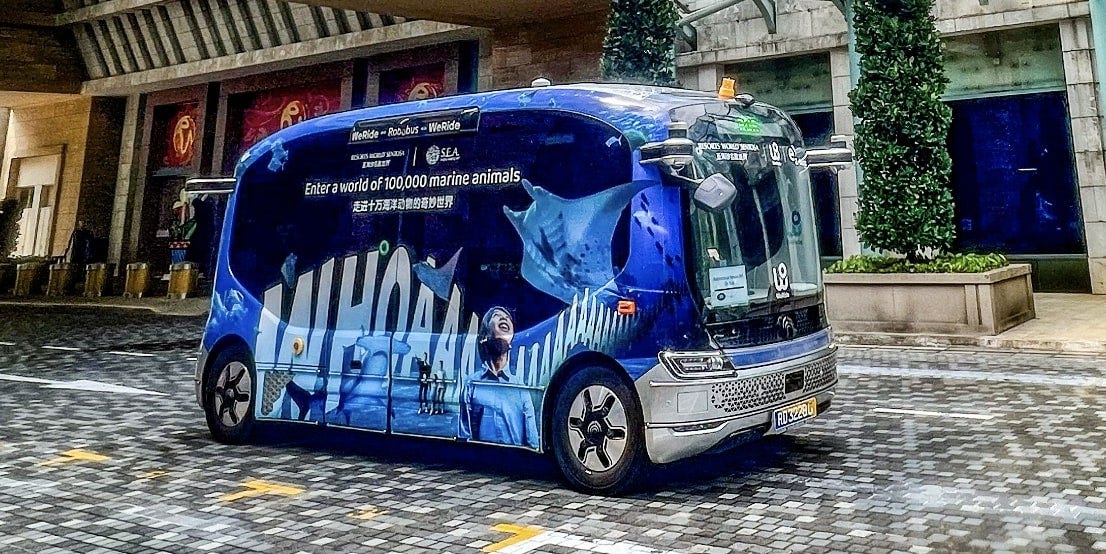China Robotaxi is Much Bigger than Waymo
By Brian Wang
Ark Invest has observed that Baidu robotaxi is several times bigger than Waymo. They also report that the robotaxi and Tesla FSD systems are already safer than human driving. These are observations that Nextbigfuture has already reported over the past few weeks in more detail.
China Robotaxi Companies are Giving More Rides than Waymo
The top robotaxi and autonomous vehicle companies in China are:
Baidu Apollo - Apollo Go, Baidu's self-driving ride hailing platform, plans 2024 plans to deploy 1,000 sixth-generation robotaxi in Wuhan by the end of 2024. The fully autonomous robotaxi operation network will reduce operating costs by 30 percent. They are using more in car safety drivers and more remote drivers. Apollo Go, Baidu's autonomous ride-hailing service, provided about 826K rides in the first quarter of 2024, up 25% year over year. As of April 19, 2024 , the cumulative rides provided to the public by Apollo Go surpassed 6 million. Apollo Go is giving about four times the rides of Waymo. Baidu has already partnered with Tesla on hypermapping for all China.
AutoX- AutoX launched robotaxi in 6 major cities around the world. In March 2023, AutoX was granted approval as Shanghai’s first driverless RoboTaxi operator. This approval marks the first time fully driverless RoboTaxis are allowed on the public roads of a downtown district in any metropolitan cities in Asia, in a major milestone for AutoX. In 2022, AutoX had over 1000 robotaxi vehicles.
Didi Chuxing - Didi Chuxing is a China' version of Uber. They are bigger than Uber with 550 million users and tens of millions of drivers. Didi is working on robotaxi. Chinese ride-hailing giant Didi Global self-driving unit's joint venture with EV maker GAC Aion has received a business license, registering itself as the first JV in China for mass production of fully self-driving electric robotaxis. In 2024, they will make a crossover electric sports utility vehicle (SUV) robotaxi vehicle. Didi has stated a goal in 2020 of reaching 1 million robotaxi by 2030.
Pony.ai - On April 26th, 2024, Pony.ai, Toyota China, and GAC Toyota established a joint venture company, namely Zhuifeng Intelligent Tech (Guangzhou) Co., with a combined investment exceeding 1 billion yuan, aiming to scale up the production and deployment of Level 4 robotaxis. A fleet of a thousand bZ4X robotaxis will be deployed in the first phase to provide fully driverless autonomous mobility services in Tier-1 cities across China. The latest robotruck vehicle system, specifically developed for long-haul freight, was launched in November 2022. The first batch of robotrucks built by Pony.ai and Sany Heavy Truck was delivered to Cyantron (the Pony.ai and Sinotrans JV) in batches, further expanding the scope of robotruck commercial operations.
WeRide. WeRide has a variety of robotic driving vehicles. They have robobuses and agricultural and industrial equipment.
Baidu Apollo seems to be a world leader with more rides given and miles driven than Waymo (Google backed US leader in robotaxi).
Apollo, AutoX, Pony.ai, Didi and WeRide each have hundreds of robotaxi vehicles and operate in 10 to 25 cities in 2024 and could be up to 65 cities in 2025. Apollo, Didi, AutoX and Pony.ai could have thousands of robotaxi in 2025. Apollo is targeting to become profitable in 2025.
Dozens of cities have been granted licenses for pilot zones for some forms of autonomous vehicle. In December 2023, China’s first national regulations on commercial operation of autonomous vehicles went into effect. Roboshuttles or robotrucks still need to have in-car safety operators, while robotaxis can use remote operators. The ratio of robotaxis to remote operators cannot exceed 3:1, and operators need to pass certain skill tests. There are also rules specifying what data the companies need to report when accidents happen.
Robin Li, co-founder and CEO of Baidu, said Baidu Apollo Go aims to expand services on its autonomous ride-hailing platform Apollo Go to 65 cities in 2025, and to 100 cities in 2030. They plan to deploy tens of thousands of autonomous vehicles across China.
Deep Dive into Robotaxi, FSD vs Human Driving Safety
Tesla FSD/Autopilot is already about eight times safer for highway driving than humans in the same vehicle.</a> Tesla vehicles have superior passive safety systems.
Failed Interventions (where humans miss potentially “correcting” for the self diving system) most of the time would not lead a crash. Even failed critical interventions would not result in a injury crash. About 1 in 200 human car crashes result in fatality. About 1 in 5 result in injury.
1.2 million deaths worldwide, 50 million injuries each year globally. About 10-20 trillion miles driven. 3 trillion in the USA. In the USA, 1 collision per 600k miles.
Humans in San Francisco had the highest rate of crashes where an injury was reported with 5.55 incidents per million miles, which was approximately three times higher than the national average. Human drivers in San Francisco have reported injury crashes every 180,000 miles. There is a non-injury or injury crash about every 30,000 to 40,000 miles in San Francisco.
Failed Interventions (where humans miss potentially "correcting" for the self diving system) most of the time would not lead a crash. Even failed critical interventions would not result in a injury crash. About 1 in 200 human car crashes result in fatality. About 1 in 5 result in injury.
1.2 million deaths worldwide, 50 million injuries each year globally. About 10-20 trillion miles driven. 3 trillion in the USA. In the USA, 1 collision per 600k miles.
Humans in San Francisco had the highest rate of crashes where an injury was reported with 5.55 incidents per million miles, which was approximately three times higher than the national average. Human drivers in San Francisco have reported injury crashes every 180,000 miles. There is a non-injury or injury crash about every 30,000 to 40,000 miles in San Francisco.
Swiss Re study of Waymo demonstrated:
An 85% reduction or 6.8 times lower crash rate involving any injury, from minor to severe and fatal cases (0.41 incidence per million miles for the Waymo Driver vs 2.78 for the human benchmark)
A 57% reduction or 2.3 times lower police-reported crash rate (2.1 incidence per million miles for the Waymo Driver vs. 4.85 for the human benchmark)
Keep reading with a 7-day free trial
Subscribe to next BIG future to keep reading this post and get 7 days of free access to the full post archives.


